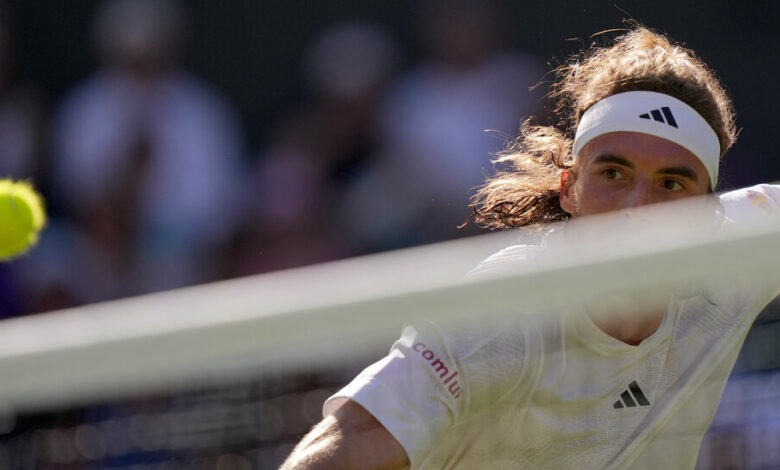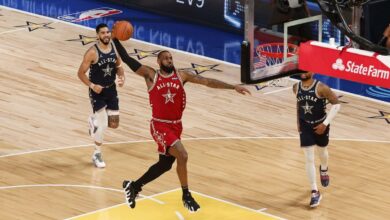To beat the best at the ATP Finals, players may have to shake things up

The ATP Finals, which take place from Sunday to November 19, are more than the most prestigious men’s tournament outside the Grand Slams; they are also an existential issue.
The exclusive singles draw features the top eight players in the world. There is no easy win and it raises the question of whether a player needs to adapt their game throughout the week to beat the very best.
The answer is a very qualified “yes,” with a giant “but.” Paul Annacone, the Tennis Channel analyst who coached Pete Sampras and Roger Federer, said the changes should be small, especially since the early matches are round-robin, meaning a player can lose one match and still survive.
“I’m a big believer in finding your own identity and trusting what got you to the end-of-year championships,” he said. “Then you just have to do a little bit better than the guy on the other side of the net that day.”
Attacking the net, which can shorten rallies and help players take control of the action, is a tactic players can employ against the game’s best defenders, such as Novak Djokovic and Daniil Medvedev, or powerful sluggers such as Jannik Sinner and Andrey Rublev. But it’s precisely these players’ skills that make coming to the net after a groundstroke such a risky move.
Still, Jimmy Arias, who is also an analyst for Tennis Channel, says this is a way to survive the week.
“It’s so hard to hit through base liners like Alexander Zverev and Medvedev, especially on a slower court,” he said, “so if you don’t come to the net against Medvedev, you’re kind of an idiot. If he hits a ridiculous passing shot from the stands, just clap and say, ‘Let me see you do that again.'”
The danger comes, says Arias, when you try to force the net against an opponent who dictates the points. However, he adds that given the quality of the opponent in Turin, Italy, this may be the only option.
ESPN analyst Patrick McEnroe agreed, saying that “the ability to score points, especially at the net, helps exponentially” against such elite defenders. Medvedev, known for his stubborn attitude, stays extremely far back from the baseline, giving himself time to make almost every deep shot. The best plan is to come to the net or hit short-angle balls against him, McEnroe said, but noted that Medvedev succeeds because many players (Djokovic and Carlos Alcaraz excepted) can’t execute that tactic well enough to beat him.
McEnroe added that the court in Turin, being indoors, has little bounce (forcing opponents to intercept passes) and is relatively slow, though indoor courts feel faster because there are no elements such as wind.
“That’s good for the aggressive player, but not as much as before, so you need more versatility now,” he said. “That’s why Federer and Djokovic have dominated there.” (Federer has won six times; Djokovic is seeking his seventh title.)
He stressed that changing strategies can be more nuanced than just attacking, suggesting using the forecourt more often and hitting drop shots, low slices and short-angle balls.
“It puts the other player in an uncomfortable position and gives you the opportunity to take the initiative on the next shot,” he said, adding that it’s something they now emphasize at the John McEnroe Tennis Academy, the school founded by his brother, where he is co-director.
“That’s the biggest thing that’s changed with Carlos Alcaraz, who’s been playing these shots since he was 13,” McEnroe said. “He’s got the tremendous firepower and athleticism of these other players, but now you see the need to move better and use that part of the court strategically. You see shots you never thought of and players are using them consistently.”
Arias said breaking an opponent by making him change his position to make him feel uncomfortable — something Federer would do with a short, low slice and Alcaraz does with the drop shot — was essential.
“It’s not only necessary for this tournament, but to beat the best you need it all year round, but it’s something that’s a little bit missing in the game today,” he said.
While Zverev and Medvedev tend to camp at the baseline and take a chance, analysts call Rublev, who Annacone called “so dominant from the back of the court,” the most one-dimensional of the top players. Arias said Rublev and Sinner “play straight, hit hard without opening the court much.”
But Annacone and McEnroe said Sinner improved in that regard thanks to his coach Darren Cahill. “He’s getting better at playing with subtlety and nuance,” McEnroe said, adding that Holger Rune also “has the potential to play that kind of game.”
All three analysts believe that Stefanos Tsitsipas, when in top form, is versatile and one of the better volleyers.
Annacone said that a player like Sinner or Rublev could win most matches of the year with their firepower, but that “any of these top players, aside from Novak, could be vulnerable against other elite players on any given day.”
Djokovic, as ever, remains the exception, even among the exceptional. He has lost just five times this year and is 33-1 on hard courts; since 2012, he is an astonishing 108-15 indoors. (Alcaraz would have folded with Djokovic there, but he has struggled since Wimbledon.)
Annacone acknowledged that players cannot change their identity for this tournament, but if they reach the semi-finals and potentially face Alcaraz and Djokovic, “you have to be creative and think outside the box”, adding that it is now easier to change tactics mid-match as coaching between points is allowed.
“You have to be confident enough to do things a little bit differently, to adapt and change on your feet,” he said. “Try it, sometimes you’ll miss, but that’s life.”




